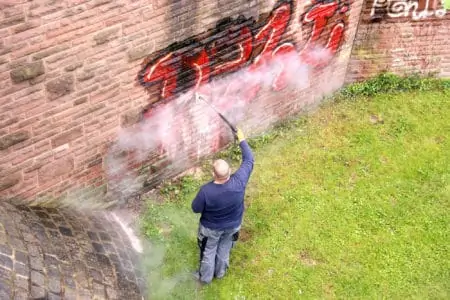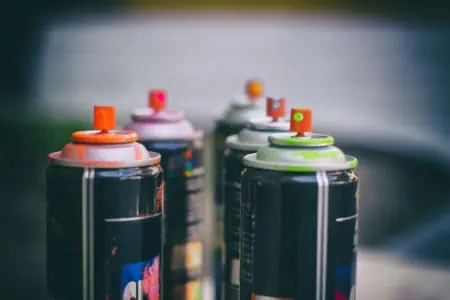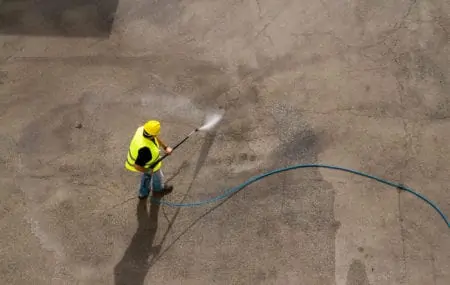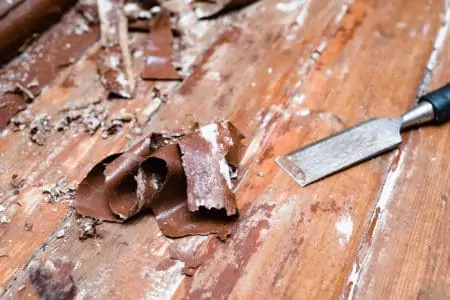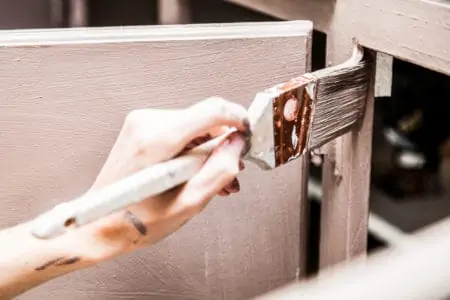Using spray paint is a fun way to upcycle tired furniture and other well-used objects, but it isn’t easy to control. Accidents are common, so knowing how to remove spray paint will make life so much easier.
From spray paint remover to vinegar, we show you how to get spray paint off several materials and surfaces.
Key Takeaways
- Identify the paint type: Determine if the spray paint is water-based or oil-based, as this will affect the removal method.
- Use appropriate removal methods: For water-based paints, try soap and water or baking soda and vinegar. For oil-based paints, use vinegar, thinners, or essential oils.
- Consider the surface: Different surfaces, such as wood, metal, or plastic, may require different removal techniques, such as scraping, power washing, or using a cloth soaked in a cleaning agent.
- Protect yourself and the environment: Wear safety gear, such as gloves, goggles, and face masks, when using harsh chemicals or power tools. Always work in a well-ventilated area.
- Identify the Paint Type
- How To Remove Spray Paint from Skin
- How To Remove Spray Paint from Concrete, Brick, and Stone
- How To Remove Spray Paint from Glass or Mirrors
- How To Remove Paint from Metal and Vehicles
- How To Remove Spray Paint from Fabric and Clothes
- How To Remove Spray Paint from Plastic
- How To Remove Spray Paint from Wood
- FAQs
Identify the Paint Type
Knowing how to get the paint off is one thing, but you need to know what type of spray paint you are dealing with first.
Water-Based
Water-based spray paints are the most common variety. They adhere well and are very tricky to remove. However, because they are water-based, they respond well to cleaning agents. Baking soda and vinegar might be good natural options to lift the paint.
Oil-Based
Oil-based paints are trickier to remove and require a cleaning agent that breaks down the oil to lift it from the surface. Vinegar and thinners are very effective at stripping oil-based paints. Just be aware that thinners might smear the paint rather than remove it entirely, and they are extremely flammable. Plus, you need a face mask to cope with the fumes.
How To Remove Spray Paint from Skin
Using cans of spray paint means that you are going to have multi-colored fingers. So, how do you get it off your skin?
What You Will Need
- Liquid dish soap.
- Pure essential oils.
- Toothbrush.
- Cloth or towel.
Water-Based Paints
1. Dish Soap
Consult the label on the can to determine what type of paint you are using.
Start by adding a few drops of dish soap to the affected area of your skin. Gently massage the soap into your skin using circular motions for about two minutes.
2. Use the Toothbrush
Wet the bristles of the toothbrush under hot water. Gently work the same area in circular motions for another two minutes. Rinse with warm water.
Oil-Based Paints
1. Like for Like
The basic principle of removing oil-based paint is using like for like. So, oil dissolves oil. Add a couple of drops of the essential oils to the affected area on your skin. Massage it into the paint, avoiding making contact with your eyes.
2. Rinse Clean
Rinse the paint and essential oils away with warm water. If some staining remains, reapply the oils and repeat the process. When you are satisfied, dry yourself with a towel to remove all traces of the paint and oil.
How To Remove Spray Paint from Concrete, Brick, and Stone
Concrete, brick, and stone are porous and absorb spray paint, so removing it takes two heavy-duty methods. Pressure washing and trisodium phosphate are effective at eliminating splatters from driveways, pathways, and patios.
Power washing is only useful outside, while TSP can be applied inside and out.
What You Will Need
- Pressure washer and wand.
- Garden hose.
- Safety goggles.
- Gloves and mask.
- Powdered trisodium phosphate (TSP).
- 5-gallon bucket.
- Stiff scrubbing brush.
Outside
1. Power Washer
Connect the pressure washer to the high-pressure inlet on the washer nozzle, and connect the garden hose to the water inlet. Next, set the nozzle at the end of the spray gun at a 15-degree angle.
The smaller the angle, the more concentrated the jet of water. If you set the angle above 15 degrees, you get a weaker and broader spray. Any less than 15 degrees, and you risk damaging the concrete and the mortar between the bricks.
2. Put on Safety Gear
After donning your goggles, it’s time to turn on the water supply and the pressure washer. Distance yourself about 4 feet from the painted surface and depress the trigger on the power washer.
Work back and forth in sweeping motions, and you will see the paint start to lift off the concrete. If you need to increase the power, take a step closer to the wall and repeat the process for 10 to 15 seconds.
Take Note
Don’t get less than a foot from the wall, or you risk getting hit with a jet of water in your face.
Indoors
1. Put on Safety Gear
Before attempting to do anything, you should don your face mask, protective gloves, and respiratory face mask. When mixing the TSP solution, choose a well-ventilated area or work outside.
2. Mix the Solution
Grab the 5-gallon bucket and drop half a teaspoon of TSP into 2-gallons of warm water. Mix it well until the powder dissolves.
3. Start Scrubbing
Dip the stiff-bristled brush into the formula and start scrubbing the affected area. If the paint is proving harder to shift, let the solution of TSP sit on the surface for 20 minutes, then scrub at it again.
How To Remove Spray Paint from Glass or Mirrors
This is probably the easiest method of removing spray paint.
What You Will Need
- Rubber Gloves.
- Nail polish remover with acetone.
- Microfiber cloth.
- Water.
- Razorblade.
1. Wet the Cloth
Don the rubber gloves, wet the cloth with the nail polish remover, and press it against the spray paint to try and loosen it.
2. Wipe Away
Once you notice the spray paint start to lift, grab a clean cloth and wipe the residue away. Repeat the press and wipe technique until all the paint has been removed.
3. Cleaning Time
Grab some glass cleaning agent and clean the glass or mirror once all the paint has gone to prevent streaks.
4. Time To Get Tough
If the press and wipe method fails, press the nail polish remover onto the paint, grab a razor blade, and gently scrape the paint off the glass surface. Wash it clean using soap and water.
How To Remove Paint from Metal and Vehicles
Metal is non-porous, so removing spray paint from vehicles and other metal surfaces is reasonably easy.
What You Will Need
- Baking soda.
- Paint scraper.
- Microfiber cloth.
- Work gloves.
- Safety goggles.
- Respiratory mask.
- Paint stripper.
- Chip brush.
- Mineral spirits.
1. Mix Up Baking Soda
This is an ideal solution for removing paint from smaller objects. Grab an old metal pot and pour in a small layer of baking soda and mix it with water until it is half full.
2. Heat It Up
Pop in the stained item and place the pot on the stove over low heat for 30 minutes. Heat and baking soda will loosen the paint, causing it to lift off the surface.
3. Scrape the Paint
Lift the object from the water using tongs and place it on a dry towel. Wait until it has cooled to the touch and grab the paint scraper and gently rub away at the paint. Take care not to scratch the surface of the metal.
4. Put on Safety Gear
For larger objects, you will need to put on your goggles, gloves, and respiratory face mask. Brush a thin layer of paint stripper on the surface of the metal using a chip brush.
5. Let It Set
Wait while the paint stripper sets according to the manufacturer’s instructions. Gently scrape the paint from the surface of the metal using a stiff-bristled brush. If the paint stain persists, repeat the process with the stripper and try again.
6. Clean-Up Time
Soak a cloth with mineral spirits and wipe down the surface to remove any stubborn paint spots. Finally, dry it with a clean cloth.
How To Remove Spray Paint from Fabric and Clothes
Getting spray paint on your clothes can be challenging to remove. Luckily, there are a few techniques you can try.
What You Will Need
- Dry cloth.
- Knife.
- Nail polish remover.
- Oil-based stain remover.
- Dish soap.
1. If the Paint Is Still Wet
Grab a dry cloth and dab at the paint rather than rubbing it. Blotting the stain brings the color pigments of the material’s surface, whereas rubbing at it grinds it in.
2. Use Dish Soap
If the stain persists, add a drop of dish soap and water and rub it to remove the stain. If that doesn’t work, try using an oil-based stain remover. Add a few drops and then dab it clean using a dry cloth.
3. If the Paint Is Dry
Grab the knife and gently scrape the layer of paint from the fabric. Be careful that you don’t tear or rip the material while you do it.
4. Nail Polish Remover
Test the remover on a small area of the fabric to see that it doesn’t bleach out the color. If the test goes well, add a few drops on the hardened paint layer and let it soak in. Then, grab a cloth and start dabbing the paint away.
You may need to repeat this process several times, with the paint becoming more faded with each attempt.
Top Tip
Throw the garment into the washing machine to remove as much paint as possible before attempting any of the techniques above.
How To Remove Spray Paint from Plastic
When spray paint gets on plastic, it can be difficult to remove if it sets hard, especially as you risk scratching the surface. Using solvents and chemical agents will most likely damage the surface of the plastic.
What You Will Need
- Plastic putty knife.
- Soap and water.
- Vinegar.
- Dry cloth.
- Damp cloth.
- Soft brush.
1. If the Paint Is Wet
The minute you spot a splatter of paint, that’s the best time to tackle it. Grab a cloth and soak it in water. Now rub the stain away. If you still have some residue, you could dip the cloth in some vinegar and give it a final wipe clean.
2. If the Paint Has Dried
If you are too late and spot that the paint has dried, grab the plastic knife and gently scrape away at the stain, taking care not to scratch the surface. Once the bulk is gone, you can then use the vinegar and a cloth to remove the rest.
Use the dry cloth to rub the affected area dry.
How To Remove Spray Paint from Wood
When you get paint on your wooden surfaces, it can be tricky to get off because wood is porous. And if it’s on a favorite piece of furniture, like a cabinet, you want the paint gone without damaging your varnish.
What You Will Need
- Nail varnish remover (contains acetone).
- Lots of clean rags.
- Dry cloth.
1. Add Acetone
Locate the paint stain and add a few drops of the nail polish remover. Leave it to soak in for a few minutes. Because wood is porous, it soaks deep into the fibers. The good news is acetone in the varnish remover can even shift hardened paint marks.
2. Apply Acetone To the Rag
Add a few drops of the nail polish remover to the clean rag.
3. Rub Away the Paint
Dab the acetone soaked rag onto the paint stain, lifting the color from the wooden surface. As the rag removes the paint, it discolors. Grab a new rag and soak this in the acetone and repeat the process.
4. Clean-Up Time
Rinse the wood with clean water to remove the last remnants of the paint and the acetone. Now dry it with a clean cloth.
